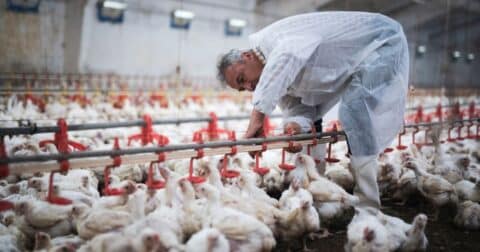Feature
Maine Was First to Ban Spreading PFAS-Contaminated Sludge on Farmland. Now Sludge Is Filling up Landfills.
Health•19 min read
Reported
With human infections of avian flu present in the U.S., workers remain most vulnerable to the virus.


Words by Nina B. Elkadi
Cases of influenza A or H5N1, also known as avian flu, are now being detected in humans across the United States. At least one person has died from the virus, and at least 67 people have been infected. For now, at highest risk of infection are poultry and dairy farm workers — people who often have close contact with animals. But as with any outbreak, the risk could change. And a number of former public health officials say the current testing approach falls short.
Researchers are monitoring avian influenza through wastewater tracking, direct testing of people who may have been exposed displaying symptoms and surveillance testing, which involves testing random samples of influenza A in humans for the H5N1 subtype.
The virus has already mutated, spreading from poultry to cattle, causing it to have “pandemic potential,” says Meghan Davis, Associate Professor of Environmental Health and Engineering at Johns Hopkins Bloomberg School of Public Health.
“If it would mutate or reassort with other viruses to the point where it could transmit human to human, that would be a big concern,” she tells Sentient. “This is the reason that we say that the virus has pandemic potential.”
“There’s a lot of mistrust for the government right now, so the [Centers for Disease Control and Prevention] has been very dependent on the states to call the shots,” Amy Liebman, Chief Program Officer of Workers, Environment and Climate at Migrant Clinicians Network tells Sentient. That approach has led to mixed results, Liebman says. “I think there are some states that are responsive, but it’s really been somewhat piecemeal…It leaves room for us to not really understand the extent of what is happening.”
One gap in testing is that not everyone who tests positive for the flu is also tested for the H5N1 subtype. In Iowa, a state dominated by factory farms and meat processing facilities, influenza A samples are usually only tested if patients meet certain criteria and if they present symptoms.
State health departments are also relying on doctors to ask the right questions. “Physicians are being urged by Iowa Health and Human Services to ask a patient if they have a potential to be exposed to infected birds or cattle,” Michael Pentella, microbiologist and director of the State Hygienic Laboratory at the University of Iowa tells Sentient. “There’s people who have been exposed that we definitely want to test and subtype.”
In addition to these measures, Iowa has a state surveillance program, through which two random positive tests from all the clinical labs in the state are subtyped for H5N1. To date, there is one confirmed positive case of avian flu in a human in the state.
In California, where the majority of human H5N1 cases have been found, physicians also play a large role in surveillance efforts. Healthcare providers are instructed to consider the possibility of infection in patients with “Signs and symptoms consistent with acute respiratory tract infection and/or conjunctivitis;” as well as a “history of exposure in the last 10 days to animals suspected or confirmed to have avian influenza A, or who have had exposure to raw milk.”
Clinicians are on the frontlines of diagnosis, and in this case, on the frontlines of tracking this virus throughout the human population. But most of those on the frontlines of the virus are migrant and immigrant workers, who may face barriers to acquiring medical care in the first place.
“When you have migrant and immigrant workforces who may distrust authority, then you also potentially have workforces that lack access to healthcare,” Johns Hopkins public health researcher Davis says. This could be driven by “distrust, fear of recognition, or perhaps a status issue,” she says. Some workers may also be infected without major symptoms. “If it presents more mild, like sniffles, a little upper respiratory sign, some conjunctivitis, even someone with access to health care might not get tested.”
In practice, getting someone tested for avian flu can be a multi-pronged maze that includes educating workers about risks, getting them access to healthcare if they are sick and hoping that a clinician has the time and knowledge to query about exposure. And even then, departments of health are relying on doctors to decide to test the person.
In her role at Migrant Clinicians Network, Liebman is working to increase knowledge of H5N1 among clinicians, as well as “raise the index of suspicion” on whose tests can get subtyped, or tested for the particular variant.
“The majority of people that have been diagnosed with H5N1 are workers. Workers are at higher risk,” Liebman says. “We need to think about this disease in terms of worker health and safety…public health guidelines, while they are important, really have to consider what it means for workers and the agency that workers have to protect themselves.” For Liebman, that means better education efforts for avian flu and PPE, not only for workers but food producers and healthcare centers that serve workers.
As President Donald Trump begins his second term as president, unexpected changes to federal agencies could upend tracking efforts. During his first week in office, the president halted all communications from governmental agencies — including the Centers for Disease Control and Prevention.
In his last term, Trump invoked the Defense Production Act and required meatpacking workers to re-open and re-enter slaughterhouses during the beginning of the COVID-19 pandemic. As many as 269 meatpacking employees died and 59,000 workers tested positive for the virus.
“When you’re talking about workers and a workforce and a food supply chain in this country, understand one of the most valuable links there are those workers that are doing that job,” Mark Lauritsen, International Vice President and Director of United Food and Commercial Workers Food Processing and Meatpacking Division, tells Sentient. “The best way to protect the fragile food supply chain in this country is through workers having a voice and a collective agreement to take care of them while they are at the workplace.”
Liebman is concerned that the new administration might be placing less of an emphasis on infectious disease during a critical time. A proposed Occupational Safety and Health Administration rule that would provide extra protections for employees from infectious diseases is now in limbo as the new administration reviews all proposed rules.
“I’m sure that this administration does not want another pandemic as it moves forward. My concerns are that we might be taking our focus off of infectious disease in general, and then off of H5N1, when we actually need a lot more focus,” she says. “We need to remember that there are really important roles that government plays in protecting human health.”